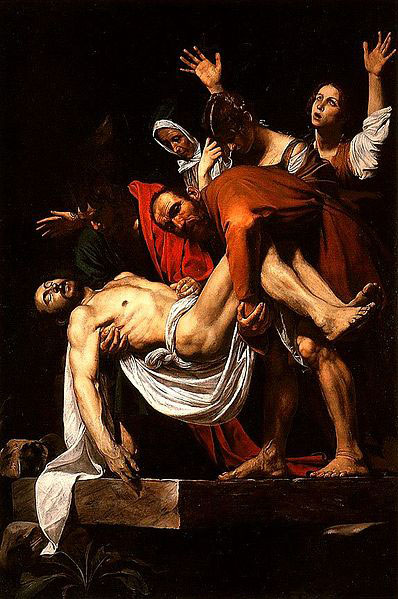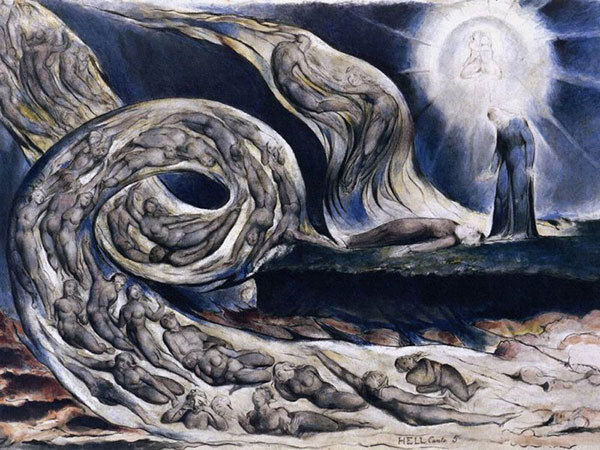
Italian Baroque and British Visionaries in Moscow
/ Главная / Russkiy Mir Foundation / Publications / Italian Baroque and British Visionaries in MoscowItalian Baroque and British Visionaries in Moscow

People continue lining up opposite the Christ the Savior Church – this time they are eager to get into the Pushkin Museum of Fine Arts. After the sumptuous Picasso, Dior and Dali expositions, the paintings of two rioters in art – the great Caravaggio and enigmatic William Blake – are now on display. Last week the Caravaggio (1571-1610): Paintings from Italian and Vatican Collections exposition opened in the museum. The master’s eleven canvases for the first time arrived in Russia from Italy and Vatican.
“It is next to impossible to organize such an exhibition and yet we did it,” said Director of the Pushkin Museum Irina Antonova. The eleven canvases currently on display at our museum actually cover all creative periods of the great Italian – A Youth with a Basket of Fruit from the Borghese Gallery in Rome, Deposition in the Tomb from the Vatican pinacotheca and Conversion of Saul (brought to the Pushkin Museum from Santa Maria del Popolo Church) are sheer classic.”
It seems amazing that Caravaggio’s paintings are kept in a church and put up only on such rare (even by world standards) occasions. The artist’s contemporaries rebuked him for vulgarization of art – it is enough to look at The Sleeping Cherub where the classical Angel of Love is depicted as a plain paunchy boy dead asleep after a hard working day, rather than as a rose-cheeked winged creature. Caravaggio’s Madonna is almost a commoner sitting with her son in a stall, rather than a meek girl of divine beauty.
“Vault light” introduced by the master makes paintings somber and heavy but amazingly dynamic at that. Each canvas is a plot and scene in its own right, with salient exemplars, characters and fates.
Special lights were set up by the Pushkin Museum for Caravaggio’s paintings that each canvas (viewed from the right angle) might take on volume and contrasting effect. This illumination makes two great paintings even more spectacular: Deposition in the Tomb where saints Nicodemus and John hold the heavy body of dead Christ while one of three Maries rolls her eyes and lifts her arms up to the skies, and Conversion of Saul where Saul falling under his horse experiences literal “rebirth” and transformation into Apostle Paul. Conversion of Saul was painted by Caravaggio specifically for a small chapel of Santa Maria del Popolo Church in Rome which has been sought until now by tourists from all over the world who want to see the great Italian’s canvases. Thanks to the efforts of Irina Antonova and her team, Muscovites have a unique chance to see these rare masterpieces until February 19.

On that same day the William Blake and British Visionaries exposition that opened on November 30 will also be closed. The engravings, water-colors and distempers by Blake who is better known as a poet than as an artist in this country are for the first time displayed in Russia. They are mainly brought from the famous Tate Gallery which has established a fruitful partnership with the Pushkin Museum in Moscow (that already helped the Museum to arrange William Turner’s exposition).
Irina Antonova said it had been decided to exhibit Blake in Moscow long ago, but the organization process took a lot of time. “In our Museum we show many canvases painted by French and Italian artists and very few canvases by British artists,” she noted. Indeed neither the Pushkin Museum nor other Russian museums have exhibited the works of Blake.
Overall about 150 masterpieces from eight biggest British museums can be seen at the exhibition. Among the exhibited works are such famous paintings as Nebuchadnezzar, Newton, Pity, Albion’s Rose, illustrations to the books of Old and New Testaments, Divine Comedy by Dante, to the works of Shakespeare, Milton and Spenser.
Like Caravaggio, Blake was not very well understood by his contemporaries. His odd religious and life philosophy was not backed by British society of the day. It says in The Marriage of Heaven and Hell: “Prisons are built with the stones of Law, Brothels with bricks of Religion.” An opponent of slavery and a champion of polygamy having a propensity towards the Gothic, Blake put all his versatile and oftentimes contradictory views not only in verses but also on paper. Some of his works reveal that he influenced Salvador Dali. Incidentally, Blake was highly appreciated by Pre-Raphaelites whose exposition will open in the Pushkin SMFA next year. Meanwhile the works of some Pre-Raphaelites like Dante Gabriel Rossetti and Edward Burne-Jones can be seen already now. Along with direct follower of Blake, George Richmond, and Blake’s friend Johann Heinrich Fuessli, they are on display in another part of the exposition called British Visionaries. Besides them, the works of legendary Aubrey Beardsley as well as those of John Piper, Cecil Collins and Francis Bacon who lived in the 20th century are also represented. The exhibition’s organizers thus emphasized that the heritage of odd Blake still influences, among other things, the modern-day processes in art.
Maria Timofeeva
New publications

 Mikhail Kalatozov, a director who transformed the world of cinematography in many ways, was born 120 years ago. He was a Soviet film official and a propagandist. Above all, he was capable of producing movies that struck viewers with their power and poetic language.
Mikhail Kalatozov, a director who transformed the world of cinematography in many ways, was born 120 years ago. He was a Soviet film official and a propagandist. Above all, he was capable of producing movies that struck viewers with their power and poetic language.  Ukrainian authorities have launched a persecution campaign against the canonical Ukrainian Orthodox Church (UOC), the biggest one in the country's modern history. Over the past year, state sanctions were imposed on clergy representatives, searches were conducted in churches, clergymen were arrested, criminal cases were initiated, the activity of the UOC was banned in various regions of the country, and monasteries and churches were seized.
Ukrainian authorities have launched a persecution campaign against the canonical Ukrainian Orthodox Church (UOC), the biggest one in the country's modern history. Over the past year, state sanctions were imposed on clergy representatives, searches were conducted in churches, clergymen were arrested, criminal cases were initiated, the activity of the UOC was banned in various regions of the country, and monasteries and churches were seized.  When Nektary Kotlyaroff, a fourth-generation Russian Australian and founder of the Russian Orthodox Choir in Sydney, first visited Russia, the first person he spoke to was a cab driver at the airport. Having heard that Nektariy's ancestors left Russia more than 100 years ago, the driver was astonished, "How come you haven't forgotten the Russian language?" Nektary Kotlyaroff repeated his answer in an interview with the Russkiy Mir. His affinity to the Orthodox Church (many of his ancestors and relatives were priests) and the traditions of a large Russian family brought from Russia helped him to preserve the Russian language.
When Nektary Kotlyaroff, a fourth-generation Russian Australian and founder of the Russian Orthodox Choir in Sydney, first visited Russia, the first person he spoke to was a cab driver at the airport. Having heard that Nektariy's ancestors left Russia more than 100 years ago, the driver was astonished, "How come you haven't forgotten the Russian language?" Nektary Kotlyaroff repeated his answer in an interview with the Russkiy Mir. His affinity to the Orthodox Church (many of his ancestors and relatives were priests) and the traditions of a large Russian family brought from Russia helped him to preserve the Russian language.

 The leaders of the Friends of the Great Russia cultural association (Amici Della Grande Russia) in Italy believe that the Western policy of abolishing Russian culture in Europe has finally failed. Furthermore, it was doomed to failure from the beginning.
The leaders of the Friends of the Great Russia cultural association (Amici Della Grande Russia) in Italy believe that the Western policy of abolishing Russian culture in Europe has finally failed. Furthermore, it was doomed to failure from the beginning.  Name of Vladimir Nemirovich-Danchenko is inscribed in the history of Russian theater along with Konstantin Stanislavski, the other founding father of the Moscow Art Theater. Nevertheless, Mr. Nemirovich-Danchenko was a renowned writer, playwright, and theater teacher even before their famous meeting in the Slavic Bazaar restaurant. Furthermore, it was Mr. Nemirovich-Danchenko who came up with the idea of establishing a new "people's" theater believing that the theater could become a "department of public education."
Name of Vladimir Nemirovich-Danchenko is inscribed in the history of Russian theater along with Konstantin Stanislavski, the other founding father of the Moscow Art Theater. Nevertheless, Mr. Nemirovich-Danchenko was a renowned writer, playwright, and theater teacher even before their famous meeting in the Slavic Bazaar restaurant. Furthermore, it was Mr. Nemirovich-Danchenko who came up with the idea of establishing a new "people's" theater believing that the theater could become a "department of public education."  "Russia is a thing of which the intellect cannot conceive..." by Fyodor Tyutchev are famous among Russians at least. December marks the 220th anniversary of the poet's birth. Yet, he never considered poetry to be his life's mission and was preoccupied with matters of a global scale. Mr.Tyutchev fought his war focusing on relations between Russia and the West, the origins of mutual misunderstanding, and the origins of Russophobia. When you read his works today, it feels as though he saw things coming in a crystal ball...
"Russia is a thing of which the intellect cannot conceive..." by Fyodor Tyutchev are famous among Russians at least. December marks the 220th anniversary of the poet's birth. Yet, he never considered poetry to be his life's mission and was preoccupied with matters of a global scale. Mr.Tyutchev fought his war focusing on relations between Russia and the West, the origins of mutual misunderstanding, and the origins of Russophobia. When you read his works today, it feels as though he saw things coming in a crystal ball...